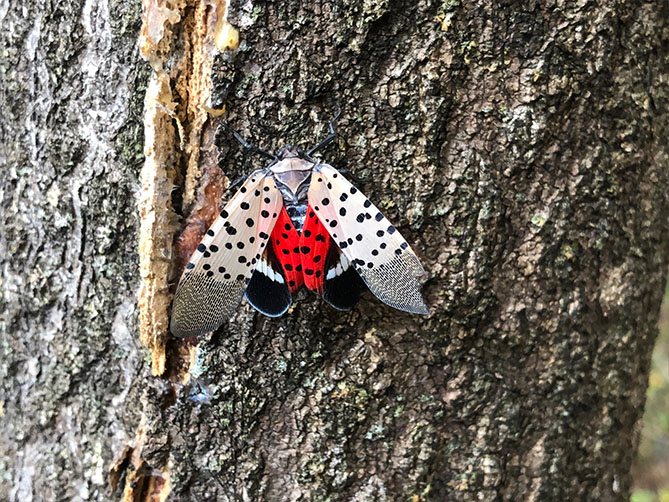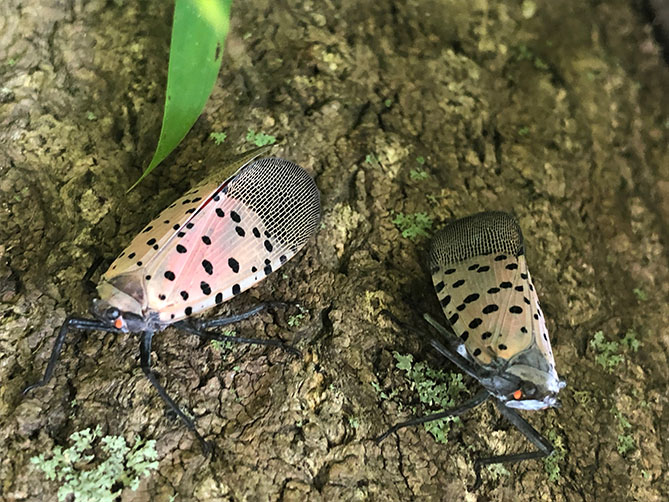Table of Contents
ToggleLast Updated on March 6, 2025

Look out Emerald Ash Borer, there’s a new invasive species taking over the headlines. The Spotted Lanternfly was first discovered in Berks County, Pennsylvania in 2014 and slowly spread into surrounding areas. Unfortunately for New Jersey residents, the spotted lanternfly was confirmed in Warren County during the summer of 2018 and also confirmed in other counties later that same year.
About the Spotted Lanternfly
The spotted lanternfly is native to Asia and it’s believed to have landed in Pennsylvania on a shipment of stone that contained an egg mass. They lay eggs in masses on any type of flat surface; this includes tree trunks, rocks, furniture and equipment left outside. The egg masses look very similar to dried up mud making them very easy to overlook. Fortunately, they only have one generation per year and adults will typically lay eggs between August and December. The nymphs hatch in the spring and are black with white spots in the beginning stages. As the nymphs get to the fourth and final instar stage, they will get red coloration on their body before maturing into adults. You can find the spotted lanternfly adults between July and December.

What does the Spotted Lanternfly Affect?
Unlike the Emerald Ash Borer that targets ash trees, the spotted lanternfly has a large range of plants that can be used as suitable hosts. The preferred host in our area is the Tree of Heaven, but the biggest concern is the potential impact on fruit trees and crops. The spotted lanternfly can feed in large numbers, impacting the overall health of the plant resulting in lower yields. The insect has been found on apple and peach trees in Pennsylvania and is a major concern for vineyards. Vineyards have already noticed lower yields on their grapes due to damage from spotted lanternflies. They have also been observed feeding on hops, walnuts and hardwood trees.
The spotted lanternfly doesn’t feed directly on the fruit or leaves, but rather it pierces through the bark or trunk of trees and feeds on the phloem. Because they can feed in such large numbers, this weakens and impacts the long-term health of the plant. As the insects feed on the phloem, they excrete a large quantity of honey dew which drips down the trunk of the tree, onto leaves, and potentially onto fruit. Any areas of the plant that have honeydew built up will start to get dark in color; this is because honeydew is an excellent food source for sooty mold fungus. Sooty mold fungus on leaves hinders photosynthesis and weakens the plant. For winemakers, most vineyards do not use the grapes once they are covered in a certain amount of sooty mold fungus.
Spotted Lanternfly Control
So what can be done? For most harmful insects, natural predators play a key role in keeping everything in balance. Unfortunately, with this invasive species, their natural predators are not here to help us control the population, so we need to find other control methods. First step is to make sure we are not actively transporting and spreading the insect. If you have traveled to areas that have known spotted lanternfly populations (Southeast Pennsylvania, Warren, Mercer or Hunterdon Counties in New Jersey), check your vehicle to make sure they are not on your car. The insects are known to be excellent hitchhikers. In the fall, check your vehicles for egg masses, it is very easy to confuse them for mud so take a closer look just to be sure. If you have any of their preferred host plants in your landscape, primarily the Tree of Heaven, see if you can locate any egg masses and scrape them off the tree, killing the eggs. Another option is removing any Tree of Heaven plants you have in your landscape completely. If you’ve gone through the steps and still have adult spotted lanternflies on your property, chemical control is another option. Using a product that has a good residual activity is preferred in case more adults visit the site after the initial treatment.
Conclusion
If you live in our service area and think you have spotted lanternflies on your property, please give us a call or report it to the New Jersey Department of Agriculture. You can email pictures of suspect insects to SLF-plantindustry@ag.nj.gov or call the New Jersey Spotted Lanternfly Hotline at 1-833-223-2840 (BAD-BUG-0) and leave a message detailing your sighting and contact information.

